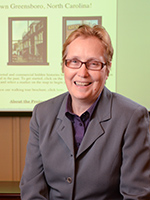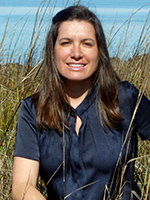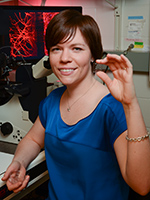2013 Impact Award Winners
Graduate Students Serve North Carolina
Each year, The Graduate School at UNC-Chapel Hill presents Graduate Education Advancement Board Impact Awards to graduate students whose research is of exceptional benefit to North Carolina. This year, we have 41 Impact Award recipients—the most since we began in 2006.
Here you can read about research projects that are truly making an impact in North Carolina and beyond. One focuses on helping families in which a parent or caregiver is diagnosed with cancer. Another focuses on bringing healthy fruits and vegetables to underserved areas. Several projects focus on helping to protect our coast and its economy. Each story centers on strong discoveries that will help our state.
These awards are privately funded through the generous support of The Graduate School's Graduate Education Advancement Board (GEAB). Recipients present their research at The Graduate School's Annual Graduate Student Recognition Celebration and receive a cash award for their accomplishments.
I hope you enjoy reading about graduate students whose research is advancing valuable new knowledge to help our state's communities and citizens.
Sincerely,
Steven W. Matson, Ph.D.
Dean, The Graduate School
Professor of Biology
2013 Impact Awards

"Lorraine has long been concerned with preserving and understanding the past, first as a reporter and columnist, and now as a scholar," said advisor Barbara Friedman, Ph.D. "Her work on this project and others demonstrates her deep affection for history as well as recognition of what's needed to communicate the past to a thoroughly modern audience."
Lorraine Ahearn, Journalism and Mass Communication
Windows to the Past: People, Places and Memory in Downtown Greensboro
Digital technology is presenting new, creative ways for the humanities to engage both the public historian and citizen who want to learn more about and contribute to perceptions of the past.
On a December night in 2011, visitors to Greensboro's downtown Elm Street Center stepped back in time through the help of doctoral student Lorraine Ahearn, who helped launch "Windows to the Past: People, Places & Memory in Downtown Greensboro," a multimedia website originally created in collaboration with a public history class at UNC-Greensboro and now available to the public.
Using the Main Street, Carolina platform of the UNC-Chapel Hill Digital Innovation Lab, as well as 19th-century maps and modern Google views, Lorraine and Kami LaBerge (a graduate student in the UNC-Chapel Hill School of Information and Library Science) designed a user-friendly walking tour to trace storefront displays and each building's changing uses over the years.
The website (mainstreet.lib.unc.edu/projects/greensboro) partnered UNC-Chapel Hill's digital expertise with the research efforts of six UNC-Greensboro graduate students. It serves as a repository that allows users to open volumes of oral history podcasts, text, digitized photos and public records information. Lorraine's collaborative efforts were instrumental in helping a major N.C. city preserve its past and make it easily accessible to the present.

Photo courtesy of Andrea Anton Gamazo
"Her research could prove critical to rescuing North Carolina's high-dollar commercial fishing industry as well as a recreational fishery that engages many North Carolinians and creates high economic value," said advisor Charles Peterson, Ph.D.
Andrea Anton Gamazo, Environment and Ecology
Ecology and Evolution of the Lionfish Invasion of the Caribbean
Lionfish have arrived off the North Carolina coast, where they have become one of the most abundant fish predators and a major conservation concern.
Previous terrestrial and freshwater studies have illustrated the devastating ecological effects that invasive predators can exert on naïve prey, including regional species extinction. Doctoral student Andrea Anton Gamazo performed extensive studies of the non-native lionfish's invasion of marine ecosystems. Her research discovered that numerous fish species do not identify the lionfish as a predator—the most dangerous form of prey naiveté because it prevents anti-predator responses.
The lionfish diet includes such species as grouper and snapper, important to the North Carolina coastal economy. The wide distribution of lionfish could have devastating consequences for local fisheries and the state's economy.
Andrea's research adds crucial knowledge to enhance management of this exotic predator in North Carolina.

"While analyzing the microbial ecosystem in the Tar River, John Paul developed new microbial indicators for water quality assessment during hurricane-flood induced environmental perturbation," said advisor Andreas Teske, Ph.D. "John Paul's extensive and unusual dataset on hurricane impact on the microbial water quality of North Carolina rivers can be used to help monitor riverine water quality and understand microbial diversity."
John Paul Balmonte, Marine Sciences
Assessing the Impacts of Hurricanes on Water Quality
In recent decades, tropical storms and hurricanes have brought extensive flooding to eastern North Carolina. Devastation is generally assumed to be obvious to the eye, but powerful storms also can have an impact on river and coastal ecosystems that is not obvious.
In 2011, while many residents of eastern North Carolina fled the ravages of Hurricane Irene, master's degree student John Paul Balmonte traveled to the affected area—specifically, the Tar River—to collect post-storm water samples to generate an extensive dataset on riverine microbial communities. John Paul's goal was to learn how a natural disaster could bring about drastic changes to the river ecosystem particularly by investigating alterations in microbial community composition and understanding their implications on water quality.
John Paul's project involved outreach to 13 middle and high schools located near the Tar and Neuse rivers on how to monitor water quality. His efforts are enhancing a field of research aimed at better understanding how extreme weather events affect the health of North Carolina's agricultural and recreational waterways.

"Considering the increasing numbers of people living in North Carolina afflicted with asthma and health-care costs associated with asthma exacerbations, her mechanistic insights are of great public health importance and could uncover potentially novel therapeutic strategies," said advisor Ilona Jaspers, Ph.D.
Rebecca Bauer, Toxicology
The Role of the Inflammasome in Asthma
Asthma symptoms are estimated to affect more than 600,000 North Carolina residents and can lead to hospitalization and death. The most common cause of an asthma attack is viral infection, as caused by the influenza virus. Though people with asthma are no more likely catch a cold or "the flu," infections may be more serious for people with asthma.
Doctoral student Rebecca Bauer seeks to understand the immune responses underlying influenza-induced asthma symptoms. Rebecca's research indicates that the cells that line the airways of the lung are modified by asthma, leading to a more severe immune response to influenza infection that may worsen asthma symptoms. Rebecca's study may uncover new therapeutic targets for reducing the impact of virus-induced asthma symptoms.
As the number of people living in North Carolina who have asthma increases and health-care costs associated with asthma climb, Rebecca's research further informs practical and effective public health interventions focused on decreasing influenza-related asthma complications.

"His writing leads a reader to stop, reflect and potentially radically alter his or her perception of others. That outcome is the deepest and most significant contribution to the region: work that quite literally builds bridges of understanding," said advisor Jocelyn Neal, Ph.D.
Will Boone, Musicology
Hearing Faith: Experience, Belief and Popular Music in the Lives of African- American Spirit-Filled Christians
Doctoral student Will Boone spent hundreds of hours attending services at Durham's Faith Assembly Christian Center, experiencing fellowship with members, conducting interviews, and rehearsing and performing with the church band. He characterizes his research methodology as "participation and conversation," focused on two purposes with an impact on North Carolina.
One, his project shows the extent to which one church is striving to strengthen the African-American community in the state. Among the many interactions he has documented are moments that churchgoers believe spiritually empower the community to be able to achieve their goals in counteracting the harsh realities of youth crime and incarceration.
Two, his research details the practices of music and dance in the kind of local church community that has long been important for the nurturing of Durham's rich African-American musical heritage. His findings draw attention to how Faith Assembly transforms mass-media-disseminated songs, styles and ideas to give them local resonance.
Ultimately, Will shows how believers at Faith Assembly use popular music and dance not only to reinforce the community in the face of great challenges, but also as means to negotiate, nuance and critically examine theology in ways that are thoroughly grounded in a rich sense of biblical and cultural tradition.

"I have absolutely no doubt that James will be an extraordinary and exemplary physician-scientist who will provide significant contributions to science and translational medicine in his career," said advisor Joseph DeSimone, Ph.D.
James Byrne, Pharmaceutical Sciences
The Creation of Minimally Invasive Electric-Field Assisted Drug Delivery Devices for the Treatment of Solid Tumors
Pancreatic cancer is the fourth leading cause of cancer death in the state of North Carolina. Chemotherapy has shown very limited effectiveness in treating pancreatic cancer, and one leading reason is that the current standard-of-care therapy cannot penetrate tumor tissue.
Doctoral student James Byrne designed and fabricated an electric field-assisted delivery device that would administer gemcitabine directly into the tumors. His preliminary evaluations of the device's effectiveness in a mouse model with patient-derived pancreatic tumors indicate a greater reduction in tumor volume using the device compared to intravenous gemcitabine.
Overall, local drug delivery using the device has potential paradigm-shifting implications for the treatment of pancreatic cancer and other difficult-to-treat solid tumors. Drug delivery using the device may also reduce the side effects that accompany intravenous administration of chemotherapies and improve the quality of life for pancreatic cancer patients.

"In his Ph.D. research, Liheng Cai has made a major discovery that will affect lives of many North Carolinians, as the treatments based on his discovery for several lung diseases are being currently tested in pulmonary clinics in the state," said advisor Michael Rubinstein, Ph.D. "I have no doubt that his discovery will have a long-lasting effect on the life quality of many citizens."
Liheng Cai, Applied Sciences and Engineering
Structure and Function of Airway Surface Layer of the Human Lungs
Chronic lung disease is the third leading cause of death in the United States. An understanding of how healthy lungs clear themselves of mucus (and how this function fails in disease) could lead to insights into lung diseases such as chronic obstructive pulmonary disease and cystic fibrosis.
Recent doctoral graduate Liheng Cai, Ph.D., helped uncover one of the mysteries in the research field—the structure and function of the human airway surface layer—during work at the Cystic Fibrosis Center at the UNC-Chapel Hill School of Medicine. He is currently collaborating with researchers and doctors at the center to use his discovery for the development of treatments for these diseases.
Liheng's research findings have led to a greater understanding of the physical mechanisms of a number of common lung diseases. His discoveries provide new directions in developing novel treatments for these diseases—and possibly for other diseases where mucosal clearance is involved.

Photo courtesy of Joey Crosswell
"Joey clearly has the potential, desire and ability to make fundamentally important contributions to the fields of environmental engineering, biogeochemistry and applied environmental biology," said advisor Hans Paerl, Ph.D.
Joey Crosswell, Environmental Sciences and Engineering
Greenhouse Gas Emissions from Coastal Waters and Implications for a Stormier Future
As part of a collaborative project, doctoral student Joey Crosswell focused on carbon dynamics of the Albemarle-Pamlico Sound system, the second-largest estuary in the nation, and how air-water interactions mediate atmospheric levels of the greenhouse gas carbon dioxide. The issue is central to maintaining this invaluable aquatic system: Carbon dioxide uptake and release affect food web dynamics and water quality in estuarine and coastal waters.
In late August 2011, Hurricane Irene passed directly over eastern North Carolina—and Joey's research site. By deploying carbon dioxide sensors on research vessels and North Carolina ferries, Joey was able to quantify the effects of Irene's winds, rainfall and resultant nutrient-enriched freshwater runoff entering the Neuse River Estuary and Pamlico Sound. He showed that a single large storm event such as Irene caused enough carbon dioxide to be vented into the atmosphere to offset several years' of carbon dioxide uptake by the coastal forests, wetlands and estuaries of North Carolina.
Joey's findings have implications for improving climate change forecasting and for creating strategies to manage the North Carolina coast's risks associated with greenhouse gases.

"Over the past three years, Corey has conducted elegant experiments to identify several novel aspects of the mechanism by which axons degenerate. Corey's results have been received with considerable enthusiasm in the scientific community," said advisor Mohanish Deshmukh, Ph.D.
Corey Cusack, Neurobiology
Identifying a New Mechanism Underlying Neurodegeneration
Neurodegeneration is a key pathology of debilitating diseases such as Alzheimer's disease and involves the irreversible loss of neurons and their vital connections. Because neurodegeneration primarily affects those in mid-to-late life, the incidence of neurodegenerative disease is expected to soar as North Carolina's population ages.
During development, neurons prune back unnecessary connections by degenerating parts of their axons, the long projections that allow neurons to signal to each other. While axon degeneration is required to establish proper and precise circuitry in the young developing nervous system, aberrantly activating this same process in the older nervous system can lead to neurodegenerative disease.
The molecular mechanism by which neurons selectively induce axon degeneration remains unclear. However, doctoral student Corey Cusack has identified a new mechanism underlying neurodegeneration. Her findings reveal both significant overlap and points of distinction between the pathways controlling the entire cell's degeneration versus axon-specific degeneration. Corey's results also demonstrate how neurons control these two pathways with distinct spatial and temporal precision.
Additionally, her results have identified specific proteins that may provide new potential therapeutic targets for hindering axon degeneration in neurodegenerative diseases.

"His work has been widely cited and is being used to help identify ways to reduce medication errors," said Richard Hansen, Ph.D., who serves on Rishi's dissertation committee.
Rishi Desai, Pharmaceutical Sciences
Medication Errors During Patient Transitions into Nursing Homes
North Carolina's nursing homes are required to report data to the Medication Error Quality Initiative, and 28,000 medication errors were among the information reported from fiscal 2007 to 2009.
Doctoral student Rishi Desai examined these data, finding that 11 percent of reported medication errors involved an individual's transition into nursing home care. In further analysis of the data, it was observed that these errors occurring during patient transitions had a higher likelihood of resulting in patient harm compared to errors occurring later.
Working in collaboration with UNC-Chapel Hill's Cecil G. Sheps Center for Health Services Research, Rishi was able to identify patient and treatment factors that increased risk of a medication error. His research findings give nursing home administrators key information toward preventing future errors—and toward enhancing the quality and safety controls surrounding medication use among nursing home residents.

"Alison's research identified the need to offer programs that train families affected by cancer in effective, evidence-based coping skills," said advisor Anita Farel, Dr.P.H. "Her work will have an impact on the way services and programs for patients living with cancer are designed and implemented in North Carolina."
Alison Doernberg, Maternal and Child Health and Social Work
Supporting North Carolina Families Facing Cancer
Statistics indicate that an estimated 2.85 million U.S. children are living with a parent who has been diagnosed with cancer. In North Carolina, 52,000 people were diagnosed with the disease in 2012. What are the needs of N.C. families facing cancer?
Alison Doernberg, who received her master's degrees in 2012, focused her research on helping families in which a parent or caregiver was diagnosed with cancer. For her project, she partnered with Cancer Services, a nonprofit organization in Winston-Salem that seeks to enhance the quality of life for cancer survivors and their families.
Alison's outreach to clients of Cancer Services included focus groups, online surveys and interviews. She ultimately identified six dimensions of successful family navigation of cancer: connection, positivity, adaptability, control, acceptance and resilience. Challenges identified for families facing cancer included family communication, finances and logistics of daily living, and emotional and behavioral health. Her research will inform the development of interventions that will benefit Cancer Services clients and that will promote resilience in all North Carolina families facing cancer.

"By placing women and the family at the center of North Carolina's political history, Jennifer is casting new light on the state's unique mixture of progressivism and conservatism and helping the states' citizens understand the complex forces that have created the political landscape on which we stand today," said advisor Jacquelyn Hall, Ph.D.
Jennifer Donnally, History
The Politics of Abortion and the Rise of the New Right
The North Carolina Right to Life has held a pivotal role both in state politics and public policy since 1973. Doctoral student Jennifer Donnally explored the complex relationships among politicians, ministers, conservative intellectuals and anti-abortion activists in North Carolina who were instrumental in the creation of the organization.
Jennifer consulted articles and editorials from the major newspapers and medical and legal journals in Kansas, Massachusetts and North Carolina as well as state legislative records. She visited the main archives of the anti-abortion and abortion rights movements, as well as Presidential libraries. She also conducted 40 interviews with anti-abortion activists.
Her study, believed to be the first to draw directly on the experiences of the men and women who animated the right to life movement, sheds light on the historical and ongoing influence of this organization.
By depositing her oral interviews Southern Oral History Program archives in UNC Libraries' Southern Historical Collection she is ensuring that these activists' voices and contributions are preserved in the state historic records so that future scholars can continue to study the state right to life movement and its contributions to North Carolina and the nation.

"Shellie's thoughtful interpretation of the study's findings provides meaningful direction for research to address North Carolina's—and the nation's—substantial racial disparities in prostate cancer mortality," said advisor William Carpenter, Ph.D.
Shellie Ellis, Health Policy and Management
Prostate Cancer Care Quality Not Affected by Race
North Carolina has one of the highest death rates from prostate cancer in the United States. In addition, mortality rates for African-American men living in North Carolina are more than two times higher than that of white men in the state.
Doctoral student Shellie Ellis investigated one of the presumed causes of racial differences in mortality—quality of care—among a population-based group of recently diagnosed men. Her study found differences in treatment protocol: For example, African-American men were less likely to have surgery and more likely to have radiation compared to white men.
However, her research found that 83.5 percent of the study participants received initial treatment appropriate to their prostate cancer risk category. Eighty percent adherence is a frequently used benchmark for quality care. Her findings indicated no racial differences in the quality of initial treatment based on national consensus guidelines.
Shellie's research supports efforts to redirect scarce resources to other more promising areas for reducing mortality and eliminating racial disparities.

"This research will help develop exercise interventions to prevent re-injury that can be instituted in youth sport programs across the state of North Carolina. The development of these tools will have many benefits to the state including the reduction of injury risk, promotion of physical activity and decreased health care costs," said advisor Darin Padua, Ph.D.
Benjamin Goerger, Human Movement Science
The Effect of Anterior Cruciate Ligament Injury and Reconstruction
Participation in high school sports has increased in North Carolina during the last decade. This means that more young people may be at risk for anterior cruciate ligament (ACL) injuries. This type of severe knee trauma necessitates reconstructive surgery and extensive rehabilitation, and is associated with an increased risk for subsequent injury, osteoarthritis and joint dysfunction.
Research by Benjamin Goerger, Ph.D., focuses on understanding why those who suffer ACL injuries are at high risk for repeat injury, as well as uncertain long-term outcomes. Ben's research illuminates that ACL injury causes alterations that lead to high-risk movement patterns that cause many patients to have repeat knee injuries.
North Carolina residents report arthritis and joint dysfunction as a leading limitation to their physical activities, according to a N.C. Department of Health and Human Services report. Ben's study findings will help improve rehabilitation methods to prevent repeat injury and support rewarding physical activity for more North Carolinians across the lifespan.

"The results from Alex's research benefit the 31,000-plus customers of the treatment plant whose membranes he studies, as well as current and future treatment plants in North Carolina treating waters from the Castle Hayne and Peedee aquifers," said advisor Orlando Coronell, Ph.D.
Alexander Gorzalski, Environmental Sciences and Engineering
Treating Groundwaters From the Castle Hayne and Peedee Aquifers
In the state's coastal plain, an estimated 90 percent of the population relies on groundwater. Population growth and increasing levels of extraction are causing salt to intrude from ocean water into the fresh water sources.
The best technologies for treating these compromised water sources are nanofiltration and reverse osmosis membranes, which are subject to the accumulation of contaminants on the membrane surface, a phenomenon known as fouling. Fouling significantly increases energy requirements for water treatment. Chemical cleaning is used to reverse fouling, and thus optimized membrane cleaning strategies are essential to the operation of treatment facilities because they extend membrane life while simultaneously decreasing energy use.
Master's student Alexander Gorzalski identified the main foulants that produce extensive problems in membrane plants treating waters from the Castle Hayne and Peedee aquifers in North Carolina. He also identified an optimal cleaning agent that reverses the membrane fouling produced by these source waters.
Alex's research benefits energy efficiency within existing and future membrane filtration plants in North Carolina, and potentially within other membrane facilities throughout the world.

"Adam's work on intestinal stem cells is very important to the many North Carolinians who suffer from devastating digestive diseases and intestinal injuries," said advisor Scott Magness, Ph.D. "His findings represent the foundation for understanding the basis behind intestinal cancers and identifying new methods of treatment."
Adam Gracz, Cell and Molecular Physiology
Developing Tools to Study Intestinal Stem Cells and Cancer
Genetic mutations that cause intestinal stem cells to proliferate too quickly can result in intestinal and colon cancer—which affect about one of every 2,000 North Carolinians and represent the second leading cause of cancer deaths in North Carolina.
Intestinal stem cells (ISCs) not only play critical roles in cancer and inflammatory bowel disease; they are critical for maintaining normal bowel function and absorption of nutrients. Understanding their basic biology carries the potential of developing new treatments for cancer, inflammatory bowel disease and trauma.
Technological limitations have prevented researchers from monitoring ISC numbers and behavior under experimental conditions. Doctoral student Adam Gracz collaborated with Dr. Nancy Albritton's laboratory group (UNC-Chapel Hill Department of Biomedical Engineering), using an Albritton lab discovery to develop new bioengineered platforms allowing for breakthrough discoveries not possible with methods currently used to study ISCs.
Adam's discovery could facilitate large studies aimed at developing advanced genetic and drug-based therapies for intestinal and colon cancer.

"This work ultimately has significant long-term potential to affect the trajectory of our understanding of diverse RNA viruses that negatively impact the lives of North Carolinians," said advisor Kevin Weeks, Ph.D.
Christine Hajdin, Chemistry
Identifying Pseudoknots as Potential Drug Targets
North Carolina has one of the highest HIV-1 infection rates in the United States, with an estimated 26,000 people currently infected and 1,500 new infections every year.
To combat viruses like HIV-1, scientists often use a strategy known as structure-based drug design, in which researchers identify important structural motifs that can be used as drug targets. They then design molecules that bind, and hopefully disrupt, these targeted regions. In general, most drugs bind to protein molecules, but figuring out how to target RNA, including the RNA genomes of viruses, would be a big advance. One structure, called an RNA pseudoknot, tends to occur in key areas affecting viral activity and could make a strong drug target. However, pseudoknots are hard to predict in secondary structures and so traditional modeling techniques "overlook" them.
Doctoral student Christine Hajdin combined experimental and computational techniques to help identify pseudoknots with a very high degree of accuracy. She developed an algorithm that identified three novel pseudoknots in the HIV-1 genome and proved these structures' importance by disrupting them in viruses and then observing a significant decrease in mutant viral activity.
Her work is broadly applicable to other important RNA viruses and is already being applied to the hepatitis C virus, the primary cause of liver cancer in the United States.

"The continued development of this approach could one day lead to pre-paclitaxel treatment genotyping that guides treatment decision in order to optimize efficacy while limiting toxicity for the hundreds of cancer patients in North Carolina," said advisor Howard McLeod, Pharm.D.
Dan Hertz, Pharmaceutical Sciences
Validation of a Pharmacogenomic Predictor of Paclitaxel-Induced Neuropathy
Paclitaxel is a drug commonly used to treat breast, ovarian and lung cancer. In addition to its effectiveness, paclitaxel causes a progressive loss of dexterity and balance, known as peripheral neuropathy, in some patients. Currently there are no proven methods for predicting, preventing or treating this common side effect.
Discovery of a predictive biomarker could enable clinicians to identify patients at high risk of neuropathy prior to initiation of treatment.
Working with a cohort of patients derived from the UNC Lineberger Comprehensive Cancer Center's Carolina Breast Cancer Study database, Dan Hertz, Pharm.D., Ph.D., analyzed genetic and demographic data to establish that paclitaxel treated patients who carry a certain genotype were more susceptible to neuropathy.
Successful prospective testing for the genotype could give clinicians a predictive tool to identify which of the hundreds of patients treated with paclitaxel in North Carolina each year are at increased neuropathy risk, enabling individualization of treatment to maximize effectiveness while minimizing toxicity.

"Zack's initiative and idea for the study resulted in, for the first time, documentation of the impact of pedestrian plans on safety," said advisor Kelly Evenson, Ph.D. "His study solely focused on North Carolina and provided results that have not been studied elsewhere in the United States."
Zachary Kerr, Epidemiology
Municipal Pedestrian and Bicycle Planning to Support Safety
The N.C. Department of Transportation estimates that from 1997 to 2010, 2,312 pedestrians and 328 cyclists were killed in motor vehicle traffic crashes in North Carolina. Additionally, 28,450 pedestrians and 12,103 cyclists were injured.
Planning documents are considered essential in developing safety-related policy, yet research has not examined the impact these plans have on pedestrian and bicyclist injuries. Doctoral student Zachary Kerr examined this issue and also whether the combined pedestrian/bicycle plans and stand-alone bicycle plans differed in quality. This study, using data specific to North Carolina, suggests that plan publication is associated with a reduction of 25 percent in non-fatal pedestrian injuries and 37 percent in fatal pedestrian injuries. He did not observe this association concerning injuries involving bicyclists.
Zack's findings also indicated that recent stand-alone bicycle plans yielded higher quality components than recent combined plans.
His study documents the impact of pedestrian plans on safety and provides important information to the N.C. Department of Transportation about the public safety benefits of creating these plans.

"Ms. Kohn's results are interesting to multiple audiences, including educators and policymakers who are responsible for educating children in a changing linguistic environment," said advisor Elliott Moreton, Ph.D.
Mary Kohn, Linguistics
Growing up Linguistically Speaking: A Longitudinal Study
North Carolina students are likely to experience contact with diverse speech communities when they enter public school, yet little is known about how this increased exposure to diverse dialects influences adolescent speech development.
Doctoral student Mary Kohn used the Frank Porter Graham Project database to explore the speech development of 20 African-American children in Durham and Chapel Hill and how their speech changed in their school years—what changes happened at what ages and how those changes related to the social environment of the students. As of December 2012, she had analyzed 12,000 vowels for 16 speakers, finding early indications that vowel pronunciation may be comparatively stable between points in time.
Mary's analysis adds critical insights into how African-American English develops across childhood and how school integration levels affect these developments.
Understanding patterns of linguistic change across childhood and into adulthood is crucial for North Carolina's professionals working with youth, including teachers and speech therapists.

"Ashley is providing an important evaluation of a statewide effort with physicians that reflects many public health principles, including innovation, collaboration and data-driven solutions to a well-recognized problem," said advisor R. Gary Rozier, D.D.S.
Ashley Kranz, Health Policy and Management
Comparing the Effect of Delivery Models for Preventing Dental Caries in Young Children
In 2000, the N.C. Medicaid program began reimbursing non-dentist primary care providers (PCPs) to deliver preventive dental services to children younger than age 3 in the medical office. The estimated percent of Medicaid-enrolled children using dental services has grown from 17 percent in 2002 to 59 percent in 2011.
Despite these benefits, little is known about what happens to children when they are no longer eligible to receive preventive dental services from PCPs after age 3. Doctoral student Ashley Kranz compared the effect and outcomes associated with preventive dental services before age 3 from PCPs, dentists, both PCPs and dentists, or neither among Medicaid-enrolled children.
Ashley's early findings suggest that the setting and provider do not influence the effectiveness of preventive dental services; however, children visiting only PCPs may encounter challenges in obtaining follow-up treatment for tooth decay.
Her research will have policy implications for the N.C. Medicaid program as well as for improving access to care for the state's most vulnerable population.

"It is fair to say that Andy's approach now represents the cutting edge of what is possible in this field," said advisor Kevin Weeks, Ph.D.
Andy Lavender, Chemistry
Creating High-Quality Structure Models as First Step to New Therapies
An estimated 15,000 North Carolinians are infected by the hepatitis C virus (HCV). A majority of those with HCV will go on to develop serious liver disease, including cirrhosis and cancer.
The HCV RNA (ribonucleic acid) genome is a currently underexplored drug target that actively performs functions essential to virus viability. To date, scientists have lacked the structural models necessary to design new drugs to target the HCV genome.
Doctoral student Andy Lavender's research focuses on the development of new approaches to create high-quality structure models for RNA molecules of biomedical interest, like the HCV and HIV genomes. By combining computational and biochemical approaches, Andy created a structural model for a section of the HCV genome critical to virus infectivity. An independent research group later showed the model to be accurate at the nanometer level. Andy has also discovered new functional motifs in the HIV RNA genome.
Andy's multifaceted approach to developing RNA structure models represents an important early step in developing new therapies that would benefit thousands of North Carolinians.

"I strongly believe that this type of consistent and focused consideration to gender in the clinical setting will eventually lead to better diagnoses and therapies for women's cardiovascular disease, which is a prevalent problem within our North Carolina communities," said advisor Kathleen Caron, Ph.D.
Patricia Lenhart, Cell and Molecular Physiology
A New Molecular Pathway in Estrogen-Mediated Cardioprotection
(At right) Patricia Lenhart is standing before a work of fiber art titled "Call 9-1-1," which incorporates pieces of brightly colored fabric and a montage of news media articles about heart disease in women. The artist, Alice Engel Levinson, donated the work, which is located at the UNC Center for Heart and Vascular Care.
Heart disease is responsible for nearly one out of every four deaths in North Carolina, and, as of 2009, was the leading cause of death among females in North Carolina.
Previous research has shown that estrogen may protect the heart from disease, and this estrogen-based protection may in part be mediated by its interaction with a receptor for estrogen known as G-protein coupled receptor 30, or GPR30. However, genetic pathways regulating estrogen's cardioprotective role among women have not been clearly identified.
Doctoral student Patricia Lenhart's research focuses on the role GPR30 may play in heart disease, particularly among women. Tricia proposed that another protein, receptor activity modifying protein 3 (RAMP3), interacts with GPR30, and she found that interaction between these proteins regulates the way GPR30 functions in the normal heart and in heart disease.
Her research increases understanding of the underlying molecular pathways important in heart disease and can pave the way for better screening tools and treatments.
Patricia Lenhart is standing before a painting titled "Call 9-1-1," which incorporates pieces of brightly colored fabric and a montage of news media articles about heart disease in women. The artist is Alice Engel Levinson, and she donated the work to the UNC Heart Center.

"Not only has Dr. Leone worked to develop an important program to serve the people of North Carolina, she has developed an impressive research program around this work," said advisor Alice Ammerman, Dr.P.H.
Lucia Leone, Nutrition
Increase Access to Fresh Fruits and Vegetables in Lower-Income Neighborhoods
Statistics indicate that low-income residents of North Carolina consume fewer fruits and vegetables and have higher rates of obesity and chronic disease.
Lucia Leone, Ph.D., and her team conducted interviews and focus groups to understand the barriers and facilitators to eating more fruits and vegetables. Focus group participants reported buying fewer fruits and vegetables because their neighborhoods lacked a good variety of healthy, affordable produce, among other factors.
Based on focus group results, Lucia worked with local partners to develop and pilot a mobile market program (the Veggie Van) to bring fresh fruits and vegetables, as well as nutrition education and cooking demonstrations, to underserved communities.
The program has grown: The Green Cart program will expand the Veggie Van model to deliver food to 14 sites across Orange, Durham, Wake and Lenoir counties. Lucia and her team are evaluating the impact and sustainability of mobile market program as part of a National Cancer Institute and a Robert Wood Johnson Foundation-funded study.

"Through her work, Amy has identified numerous educational resources that provide effective strategies and tools that can be employed by teachers to promote successful school integration, and ultimately school success, for this vulnerable population of children," said advisor Patricia Garrett-Peters, Ph.D.
Amy Lerner, Education
Integration: Partnering with Local Schools to Assist Refugee Students
North Carolina is home to more than 665,270 immigrants, of which an estimated 8,500 receive local services focused specifically on refugees. Research has shown that refugee children are at risk of isolation, being bullied and performing poorly on standardized tests.
Doctoral student Amy Lerner conducted a study to determine strategies and services that could help local school personnel as they educate and support refugee children. Amy interviewed and led focus groups with 32 elementary school personnel from six schools in Chapel Hill and Carrboro. She also performed more than 25 hours of field observation.
Her findings informed the development of a comprehensive resource guide for the state's school personnel who work with refugee children. As follow-up research, she surveyed teachers who received the guide to evaluate this project's success.
This resource guide will help school personnel in their efforts toward ensuring that refugee children make a healthy adjustment to their new environment.

Photo courtesy of Meghan Lewis
"Meghan's research demonstrates that it is most important to understand how to ensure that key stakeholders have both access and understanding of the data needed to make decisions and plans for the future," said advisor William Sollecito, Dr.P.H.
Meghan Lewis, Public Health Leadership
Evaluating the Utilization of the Community Health Assessment
Local health departments in North Carolina must conduct community health assessments periodically in order to identify areas of need and to maintain accreditation. Despite widespread support for community health assessments, more work needs to be done to measure how communities use the results of these assessments to address identified concerns.
Meghan Lewis, M.P.H., evaluated how a community assessment is used, specifically among the individuals involved in completing the assessment in Cabarrus County. Her recommendations originating from respondents' answers have allowed Cabarrus County stakeholders to make adjustments and improvements to the way the assessments are publicized, distributed and used, ultimately resulting in a larger impact in the county.
In addition, the results of Meghan's study will add to the current body of knowledge about how one local health department and the key community stakeholders use a community health assessment after it is submitted to the state for accreditation.

"Ward's research offers an important contribution to knowledge on the effects of local decisions on mitigation planning processes, communication, and effectiveness of risk reduction outcomes," said advisor Philip Berke, Ph.D.
Ward Lyles, City and Regional Planning
Planner Involvement Needed in Efforts to Reduce Disaster Risks
In the 2000s, North Carolina experienced nearly $500 million in costs from the state's eight most damaging natural disasters. As the state's communities seek to lessen storm-related damage, land-use planning and hazard mitigation need to be increasingly connected.
Ward Lyles, Ph.D., examined local mitigation plans for 175 jurisdictions in six states, including 30 jurisdictions in North Carolina. He found that including a jurisdiction's own local planner in planning processes, which are typically led by emergency managers, is related to a 240 percent higher number of land use approaches included for future action in its hazard mitigation plan.
He then analyzed data for two Florida counties and two North Carolina counties. In particular, the New Hanover County (N.C.) case showed that when planners had strong connections to emergency managers and were in more central positions in the mitigation stakeholder network, land use approaches were a core part of the strategy for mitigating hazards.
Ward's results show how involving local planners in creating North Carolina's hazard mitigation plans can contribute to more proactive strategies for protecting citizens from storm hazards.

"Kyle's master's thesis resulted in a breakthrough that allowed the first successful space/time modeling analysis of groundwater PCE contamination across the State of North Carolina," said advisor Marc Serre, Ph.D.
Kyle Messier, Environmental Sciences and Engineering
Integrating Multiple GIS Methods for Estimation of Tetrachloroethylene
Tetrachloroethylene (PCE), a likely carcinogen to humans, is a dry cleaning agent and metal degreaser that contaminates the groundwater in many areas across North Carolina. PCE's distribution across the state is uncertain because monitoring is localized around known contaminant plumes.
Doctoral student Kyle Messier created a way to analyze groundwater contamination from PCE by integrating the following: address geocoding of private well data, land-use regression that accounts for point sources and flow direction, "below detect" data modeling and geostatistics.
Kyle obtained more than 2,400 new ground water PCE measurements in North Carolina through his address geocoding process. This technique alone more than quadruples the amount of groundwater PCE data available to regulators in North Carolina for making decisions related to PCE exposure.
Kyle's study provides a cost-effective, efficient and more accurate methodology for estimating exposure of North Carolinians to hazardous contaminants, which ultimately leads to better public health protection of its citizens.

"She's a hard working public health scientist who is collaborating with key people in our state's public health division and making a difference to how we think about vaccination," said advisor Noel Brewer, Ph.D.
Jennifer Moss, Health Behavior
Improving Uptake of Human Papillomavirus (HPV) Vaccine to Improve Cervical Cancer Outcomes
The vaccine that protects against human papillomavirus (HPV) can prevent several types of cancer and genital warts. Despite these benefits, uptake of the HPV vaccine remains low in North Carolina, and it is not increasing very quickly.
Doctoral student Jennifer Moss focused on why young people in North Carolina do or do not receive the HPV vaccine. Along with the North Carolina Immunization Branch, her research team adapted a CDC-recommended program into a one-month intervention to encourage providers to administer recommended vaccines to adolescents. Seventeen federally qualified health clinics statewide received the intervention, effectively increasing uptake of HPV and other adolescent vaccines among disadvantaged youth.
In another study, her team found that previously reported disparities in HPV vaccination related to socioeconomic and healthcare characteristics have significantly decreased since 2008. Through this and other related studies, Jennifer advanced findings that allow researchers and practitioners to better understand why adolescents receive or do not receive this vaccine.
Jennifer has contributed crucial research findings of use in understanding how the state can increase the provision rates of the HPV vaccine and other childhood and adolescent vaccines.

"Maya's research is evaluating health impacts in a rural North Carolina area that is traditionally underserved, and she is identifying conditions that can lead to the emergence and dissemination of antibiotic resistant bacteria," said advisor Jill Stewart, Ph.D.
Maya Nadimpalli, Environmental Sciences and Engineering
Carriage of Antibiotic-Resistant Staphylococcus aureus by Livestock Workers and Household Members
The scientific community has identified industrial livestock operations as a potential source of exposure to antibiotic-resistant Staphylococcus aureus. This presents concerns for individual and community health in North Carolina, which is one of the nation's top producers of industrially raised swine and poultry.
Doctoral student Maya Nadimpalli collaborated with members of the UNC-Chapel Hill Department of Epidemiology, as well as the Rural Empowerment Association for Community Help and the N.C. Environmental Justice Network, to determine if antibiotic-resistant S. aureus was present among industrial livestock workers and household members in North Carolina. The research team also enrolled antibiotic-free farm workers and household members.
Maya's study found that industrial livestock workers and their household members carried multidrug-resistant S. aureus in their noses more often than workers and household members from antibiotic-free farms in North Carolina. More extensive follow-up study is needed, but her research suggests an area of concern regarding community and individual health in the state.

"Facts are a prerequisite for sound policy efforts to increase the wellbeing of all North Carolinians. Unfortunately, too often the information needed does not exist or is fragmented across many sources inaccessible to those who need them. Kevin's site addresses the latter problem," said advisor Roberto G. Quercia, Ph.D.
Kevin Park, City and Regional Planning
North Carolina Housing and Mortgage Lending Data
Foreclosure records and other housing-related data are often publicly available, but scattered in unwieldy databases.
UNC-Chapel Hill Center for Community Capital research assistant and doctoral student Kevin Park created an interactive website (www.unc.edu/~kapark/NC/home.html) that incorporates foreclosure data from the Administrative Office of the Courts for North Carolina's 100 counties. Site users can gain a general sense of a county's foreclosure activity by looking at the map and also learn the precise number of foreclosure starts in a given year by scrolling over a specific county. Kevin's website also incorporates data on new home construction, lending patterns, housing vacancy, unemployment and housing prices.
Working with the UNC-Chapel Hill Center for Urban and Regional Studies, he also created a website that examines the economic health of 44 large N.C. municipalities (www.unc.edu/~kapark/CURS/intro.html).
Providing policymakers, researchers and N.C. citizens with more streamlined access to housing and mortgage lending data can allow for a more accurate view of communities in distress and their specific economic needs.

"Eliza's novel inhibitors will have a significant impact on the long-term efficacy of different antibiotics," said advisor Scott Singleton, Ph.D., "and they represent a much-needed new approach to combating bacterial pathogens."
Eliza Peterson, Biochemistry and Biophysics
Improving the Success of Antibacterial Treatment of Infections
Antibiotic resistant bacterial infections affect thousands of North Carolinians every year. They are difficult to treat and cost the health-care system hundreds of millions of dollars.
Antibiotics dramatically accelerate the rate of genetic change in bacteria, contributing to the evolution and spread of genes that confer resistance. To intervene in the emergence of antibiotic resistance, researchers are working to understand the mechanisms that connect antibiotic stress to rapid genetic change.
Doctoral student Eliza Peterson has focused on select enzymes, RecA and EndA, that accelerate the development and spread of antibiotic resistance. She developed screening programs to discover and evaluate small-molecule inhibitors of these enzymes. Her work will guide additional screening efforts to discover novel inhibitors of RecA, EndA and possibly other bacterial targets that accelerate the evolution of antibiotic resistance.
By understanding the interaction of properly designed inhibitors with enzymes that lead to bacterial antibiotic resistance, researchers can potentially develop new drugs to stop this significant threat to public health.

"Andrea's research will contribute to the development of strategies to promote healthy environments and increase neighborhood access to healthy foods," said advisor Penny Gordon-Larsen, Ph.D. "Her focus on race/ethnic disparities will be particularly important, as is her focus on primarily under-studied rural and non-urban neighborhoods—a critical need in North Carolina."
Andrea Richardson, Nutrition
Dynamic Environments and Obesity: Risky Genes?
North Carolina has the fifth-worst rate of childhood obesity in the United States, and an estimated two-thirds of all North Carolina adults are overweight or obese. The causes of obesity are complex and include biological, behavioral and environmental influences.
Doctoral student Andrea Richardson employed innovative statistical methods to explore multi-faceted factors relating specifically to the adolescent and young adult population.
Among her findings are the following:
- Recommended levels of exercise may reduce genetic risk of obesity.
- Childhood sexual and physical abuse may increase the risk of adult severe obesity.
- Policies to reduce access to neighborhood fast food restaurants as a means to reduce fast food consumption among young adults may be unsuccessful.
- While policy efforts often focus on underserved urban communities, policies should also target disparities in access to healthy foods in rural neighborhoods.
Andrea's research focuses on age groups that contain tremendous potential for obesity prevention and treatment. Her efforts will greatly assist N.C. researchers and health-care leaders working to understand complex factors related to obesity.

"Reid has shown a great willingness to engage in science across multiple disciplines as a means to improve clinical outcomes for patients suffering from a number of physically, emotionally and economically debilitating diseases," said advisor Jenny Ting, Ph.D.
Reid Roberts, Microbiology and Immunology
Programming Immune Responses with Materials Science
Immunologic diseases include both inflammatory and autoimmune disorders, which are chronic in nature and, thus, impose enormous burden on the health-care system. Asthma is the leading cause of school absenteeism in North Carolina and affects an estimated 12.9 percent of the state's adults. One potential way to enhance asthma treatment is by developing particulate delivery devices that carry immune-activating molecules into the lungs.
M.D./Ph.D. student Reid Roberts combined molecular immunology training in the lab of Jenny Ting, Ph.D., with the materials science expertise of Dr. Joseph DeSimone's research group to identify how particle design parameters can be used to modulate immune responses. His early study results suggest that nanoparticles may be effective in delivering localized and sustained therapeutics to the lungs.
To test this possibility, Reid and colleagues are now delivering immunomodulatory agents agent via nanoparticles as a means of reducing lung inflammation in a mouse model of asthma.
Reid's work may contribute to a paradigm shift in clinical medicine in the 21st century whereby the immune system will be instructed at the molecular level to re-establish health in the human body.

"Alison's efforts have influenced a statewide screening program to identify pregnant women who may be at-risk for metals exposure," said advisor Rebecca Fry, Ph.D. "Over time, this program is expected to result in lowered exposures for both mothers and newborns."
Alison Sanders, Environmental Sciences and Engineering
Assessing Arsenic, Cadmium, Mercury and Lead Levels in Pregnant Women
Arsenic, cadmium, mercury and lead are metals the Agency for Toxic Substances and Disease Registry has ranked among the top 10 most toxic substances. Maternal exposures to toxic metals may result from diet, air, drinking water, occupational exposures and/or tobacco use.
In collaboration with the N.C. Department of Health and Human Services, doctoral student Alison Sanders analyzed the levels of these four metals in the blood of pregnant women across six N.C. counties. She also examined associations of metal levels according to maternal age, race and county of residence.
Alison's data showed that a large fraction of the pregnant women had detectable levels of these toxic metals. Her study findings also indicated that maternal race and residence in certain counties were associated with elevated body burden of some toxic metals.
Her research has influenced a statewide screening program for prenatal lead exposure.
Alison's research shows that further biomonitoring of blood levels of toxic metals in susceptible N.C. populations is prudent.

"Modern aging research has suggested that noxious stimuli may contribute to human disease in part by accelerating the rate of aging in certain tissues. Jessica's work is essentially inventing the field of 'gerontogenic toxicology'; that is, how environmental exposures promote molecular aging," said advisor Norman Sharpless, M.D.
Jessica Sorrentino, Toxicology
Common N.C. Exposures Can Affect Rate of Aging
Recent research has shown that people grow old at different rates, and in particular, this rate of physiological aging can be accelerated by environmental exposures such as smoking or physical inactivity. Doctoral student Jessica Sorrentino studied how certain environmental factors affect health, specifically by promoting aging.
It has been determined that the rate of physiological aging can be measured through expression of a protein called p16. Working in the lab of Dr. Norman Sharpless, Jessica helped to generate a mouse model with built-in indicators of p16 that have a role in determining the rate of physiological aging. Jessica used this mouse model to determine the rate of aging in mice exposed to cigarette smoke, high fat diet, ultraviolet light and arsenic.
Her early findings suggest cigarette smoke, arsenic and UV light as possible agents of accelerated aging—while not finding an association between a high-fat diet and higher levels of p16.
Jessica's work will provide an understanding of the toxicology of aging, with direct relevance to the health of all North Carolinians.

Photo courtesy of Anisha Steephen
"Anisha's research will have an impact by extending the knowledge about how local jurisdictions can engage in multi-institutional and multi-sector planning for immigrant integration," said advisor Mai Nguyen, Ph.D. "Her work has already had an impact in the cities of Greenville, High Point and Durham."
Anisha Steephen, City and Regional Planning
Building Integrated Communities
Nearly a decade ago, the Brookings Institution labeled three N.C. areas as "pre-emerging" immigrant metropolitan gateways: Raleigh/Durham, Greensboro/Winston-Salem and Charlotte. The need for immigrant integration strategies in the state is critical, now more than ever.
Anisha Steephen, who received her master's degree in 2012, sought to increase understanding of local government's role in integration policies.
As part of a two-year project, Anisha identified more than 100 best practices nationwide to inform North Carolina's local outreach to immigrants. She also worked with Hannah Gill, Ph.D., and Mai Nguyen, Ph.D., to facilitate innovative immigrant integration practices in Greenville, High Point and Orange County. Among her contributions to this project, she conducted statistical analyses of the immigrant population in each of the study sites, and interviewed stakeholders to determine the assets and needs of the immigrant community.
Anisha's research was important in the creation of community action plans for two of the three study jurisdictions. Her findings will lead to enhanced local polices that integrate migrants into new destinations where they can make valuable contributions.

Photo courtesy of Jasmine Talameh
"The genetic mutation that Dr. Talameh found could potentially identify heart failure patients that require additional or alternative medications to help them live longer and reduce hospitalizations," said advisor Herb Patterson, Pharm.D.
Jasmine Talameh, Pharmaceutical Sciences
Genetic and Pharmacogenetic Associations With Heart Failure Patient Survival
Each year, heart failure kills more than 1,600 North Carolinians. Beta-blockers can keep heart failure patients alive and out of the hospital, but they only improve heart function in about 25 percent of patients. Unfortunately, characteristics such as age, gender or the cause of the heart failure do not explain beta-blocker effectiveness.
Can genetic differences predict beta-blocker effectiveness in patients with heart failure? Research by Jasmine Talameh, Pharm.D., who receives her doctorate in May 2013, identified a genotype that could potentially be used to select North Carolinians with heart failure who would benefit from beta-blocker treatment. She also found that beta-blockers may not be effective in African-American heart failure patients who carry a particular variation from that genotype.
Her findings were based on a candidate gene study of 722 heart failure patients with nine years of vital status follow-up. She studied 11 genetic variants in all.
Follow-up research is necessary, but these early findings suggest that testing for certain genetic variants could potentially identify patients with heart failure who would benefit from beta-blocker treatment.

"Bethany is making outstanding progress in uncovering mechanisms in cardiovascular disease, the leading cause of death and disability of North Carolinians," said advisor Alisa Wolberg, Ph.D.
Bethany Walton, Pathology
The Contribution of Gamma Prime Fibrinogen to Arterial Thrombosis
Cardiovascular disease is the leading cause of death and disability in North Carolina. Most deaths from cardiovascular disease are due to the formation of an abnormal blood clot, known as a thrombus, within the blood vessels causing lethal heart attacks and strokes.
Clots are made up of cells (platelets) and protein (fibrinogen). Elevated levels of a naturally occurring alternate form of the blood clotting protein fibrinogen ("gamma prime") have been associated with increased risk of thrombosis.
Doctoral student Bethany Walton studied normal and gamma prime fibrinogen, finding that gamma prime formed clots at a slower rate than normal fibrinogen did. Thus, the elevated levels of gamma prime documented in past studies may be a reflection of the body's response to the abnormal blood clot—not its cause.
Her findings suggest that total fibrinogen levels, and not just gamma prime levels, should be pursued as a therapeutic target for preventing thrombosis. A better understanding of the mechanisms behind different types of thrombosis will allow for development of better therapeutic agents to treat clots.

Photo courtesy of Jackie White
"Jackie has greatly increased our understanding of forest regeneration along the Roanoke River floodplain, and more generally along Coastal Plain rivers throughout the Southeast. Her work already has and will continue to significantly inform future river management decisions that will impact diverse stakeholders in the state," said advisor Robert Peet, Ph.D.
Jackie White, Environment and Ecology
The Impact of the Altered Floodplain Hydrology on Tree Regeneration and Floodplain Forest Composition
The lower Roanoke River, located in northeastern North Carolina, is the most extensively forested river system remaining on the Atlantic Coastal Plain. The ecological integrity and diversity of these forests are threatened by upstream dams. Tree seedling abundance and diversity are likely to diminish as a consequence of long-duration flood events that result from current dam management.
Doctoral student Jackie White has conducted research to assess the impacts of current dam management on the forests of the lower Roanoke and to guide the team responsible for developing and implementing a management plan for the river that balances the stakeholders' varied interests and protects the integrity of the forest ecosystem. To study the relationship between flooding and tree regeneration, she monitored tree seedlings on the lower Roanoke River floodplain from 2007 to 2011 and re-sampled long-term vegetation plots established in 1994. She also monitored data flooding patterns at her vegetation plots using a series of water-monitoring wells.
Her findings indicate that tree seedling richness and abundance decrease with increasing flood duration. Long-duration mid-growing season flooding resulted in the lowest survivorship of tree seedlings. Jackie's results suggest that in order to maintain current levels of floodplain forest cover and diversity, the dams should be regulated to allow more frequent high-magnitude floods while minimizing long-duration growing-season flooding.

Photo courtesy of Alyssa Wittenborn
"As one of the few studies of its kind in the United States, this study has provided substantial insights about farmer responses and program effectiveness. Her findings contradict stereotypical views of farmer resistance to adoption of programs," said advisor David Moreau, Ph.D.
Alyssa Wittenborn, City and Regional Planning
Agricultural Nutrient Management in the Neuse River Basin
North Carolina has adopted regulations aimed at nitrogen pollution sources in several river basins.
The Neuse Nutrient Management Rule requires agricultural producers in the Neuse River Basin who manage or apply fertilizer to 50 or more acres of cropland either to participate in a nutrient management training workshop or develop a farm-specific plan for managing nutrients. The rule does not require producers to take any specific actions to protect water quality.
Using data from a telephone survey of 415 agricultural producers, Alyssa Wittenborn, Ph.D., evaluated the rule's effectiveness in encouraging voluntary adoption of best management practices regarding water quality. The N.C. Division of Water Quality funded the survey. She collaborated with N.C. State University faculty to develop the questions.
Alyssa found that the rule increased use of practices that promote judicious application of fertilizers. However, the structure of the rule undermines the practice of planting cover crops in the winter to remove excess nitrogen from the soil and prevent it from being washed into surface waters. The study also identifies types of producers who are not well-informed about the rule.
These results can help the state more effectively target outreach, enhance design of the current rule, and develop more successful future strategies.
